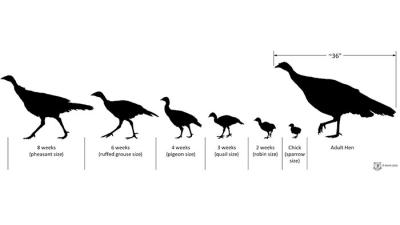Turkey Surveys
Welcome Turkey Observers
Winter Turkey Flock Survey
New Hampshire Fish and Game's winter turkey flock survey runs January 1 through March 31.
Summer Brood Survey
Watch for turkeys next summer, too! Fish and Game also needs turkey observers for its spring/summer turkey brood survey (conducted from June 1 - August 31 each year). The public can help New Hampshire Fish and Game biologists estimate how many young turkeys survive into adulthood in a particular year by taking part in the spring/summer turkey brood survey.

Robin size = 2-week-olds
Quail size = 3-week-olds
Pigeon size = 4-week-olds
Grouse size = 6-week-olds
Pheasant size = 8-week-olds
Turkey Watching Guidelines
- Is this your first time visiting this site? Please take a moment to review the guidelines below.
- Date of sighting is required. Only report sightings made in New Hampshire through August 31.
- Do not report sightings of adult male turkeys.
- Tell us the relative size of poults when you observed them. Size is important, because it allows Fish and Game to approximate the hatching date of respective broods. For example, if you report a hen with “robin sized” poults on July 1, we can estimate that the brood hatched on or about June 15, since poults that size are about two weeks old. The following list provides you with a guide to describing the size and age of chicks/poults you may observe during the summer months:
- When reporting mixed flocks, we ask that you tally the number of hens present, and the number and relative size of poults observed. For example, you might report a flock of 3 hens and 15 poults, divided amongst robin and grouse sized poults. On the survey, report how many hens, “robin sized” and “grouse sized” poults were in the flock.
List the town of your sighting and use the reference map to identify the Wildlife Management Unit (WMU) where the sighting occurred. Note that WMUs are depicted by a capital letter and that some WMUs have both a letter and a number in their label, for example A, B, D1, D2, E, etc.
Summary of Things to Report
- Date flock seen,
- WMU,
- Number of hens,
- Number and size class of poults – which may be divided amongst multiple age classes.



